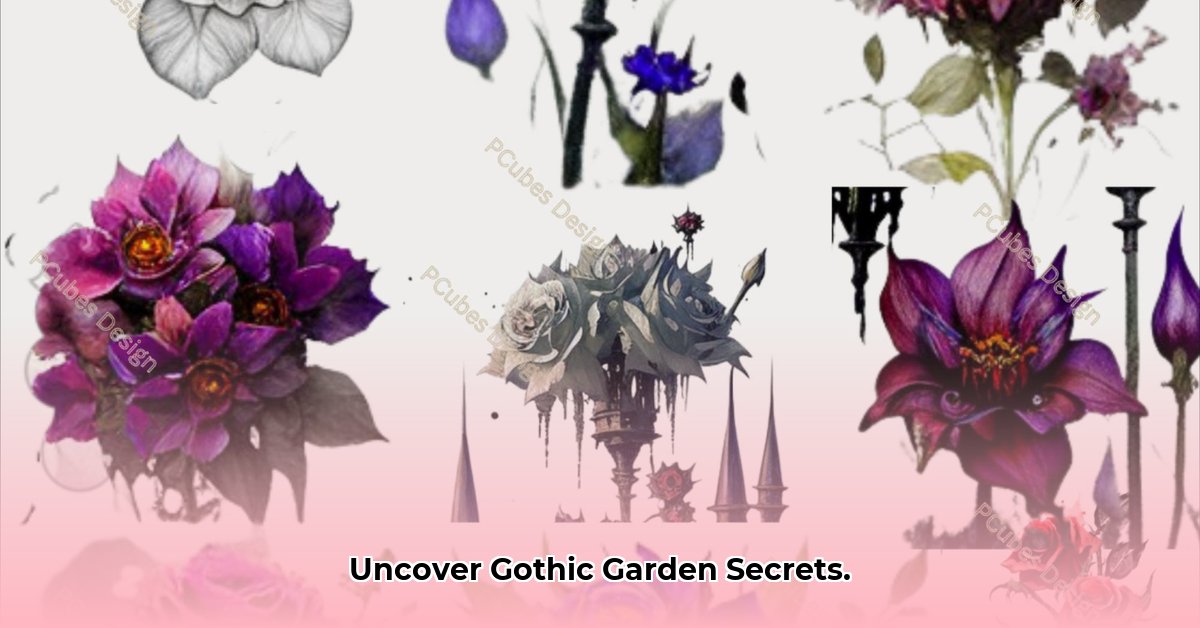Ever wanted a garden that feels like it belongs in a gothic novel, echoing with whispered secrets and shadowed beauty? Imagine a space brimming with deep purple flowers, shadowy trees that stretch towards the moon, and an aura of mystery that captivates the soul. This comprehensive guide will reveal how to craft your unique, cool, dark, and dramatic gothic garden. From selecting the right spooky plants to designing the perfect haunting backdrop, we’ll cover every detail, making it manageable for seasoned gardening pros and beginners alike. Get ready to transform your outdoor area into a stunning sanctuary of shadows and splendor, ensuring it remains captivating year-round, and also how to choose the best dark plants for a gothic garden design!
How to Choose the Best Dark Plants for a Gothic Garden Design
Creating a gothic garden is less about “gloom and doom” and more about embracing a sophisticated, mysterious aesthetic. It’s about designing a space that subtly whispers secrets, where shadows playfully dance and romance thrives unexpectedly under the moonlight. Discard the clichés—graveyards and skeletons aren’t required. Instead, focus on rich colors, intriguing textures, and a carefully chosen collection of plants that evoke drama and quiet intensity. Think velvety darkness, deep purples suggestive of twilight skies, and the enticing allure of near-black blooms. Expert insights note that the dramatic contrast of a stark black dahlia against the silvery leaves of artemisia enhances the aesthetic, creating a visually arresting focal point.
Defining “Gothic Flowers”: More Than Just Dark Hues
What is a gothic flower, you ask? It extends far beyond mere black petals! The true beauty of a gothic garden lies in a broad spectrum of colors and textures that, when harmonized, evoke a sense of the sublime. Picture deep, velvety purples that seem to absorb light, intense crimson reds with an almost sinister glow, or the refined shadowy browns of dried seed heads – each hue contributing to the garden’s overall narrative. Capturing a feeling—mystery, drama, perhaps even melancholy—is key. Even a plant’s structure matters: spiky leaves that add an element of danger, elegantly drooping blossoms that suggest sorrow, or unusual shapes that defy expectations all amplify the gothic effect. Visual appeal isn’t the only consideration; creating an atmosphere that resonates with the soul is essential. As garden enthusiasts know, the goal isn’t just to please the eye but to stir the deepest emotions.
Building Your Gothic Garden Palette: A Plant Lover’s Guide
Let’s discover specific plants that perfectly embody the gothic essence. Remember, this magic results from combining colors, textures, and subtle scents that create a multi-sensory experience. Discovering the perfect mix for your unique space is part of the fun and ensures a thriving garden in your specific climate. Here’s a curated gothic garden plants list to start, grouped to help you easily choose plants suited to your garden’s distinct conditions. As noted by The Gothic Gardener’s Handbook, dark-colored plants are the cornerstone of a gothic aesthetic, providing the visual anchor around which the rest of the design is built.
Deep Purples and Near-Blacks:
- Black Dahlias (Dahlia cultivars): These bewitching beauties are nearly black and bring an air of gothic elegance. They prosper in full sun with well-drained soil, excelling in hardiness zones 7-10. Their association with death adds to their mystery. Did you know that black dahlias symbolize death, inner strength, and enduring love? To encourage more blooms, regularly deadhead spent flowers.
- Papaver somniferum ‘Black Paeony’: These opium poppies offer a rich, dark purple-black hue, reminiscent of a moonless night. They need full sun and well-drained soil (zones 5-8). Poppies are striking but short-lived, adding a fleeting beauty to the garden. Historically, they’ve been associated with sleep and forgetfulness, fitting for a gothic garden! Sow seeds directly in the garden in early spring for best results.
- ‘Nigra’ Hellebore (Helleborus niger): These winter bloomers present deep, dark purple-black flowers, offering a gothic touch even in the coldest months. They prefer partial shade and moist, well-drained soil (zones 4-9). The hellebore symbolized fear and foreboding, but also strength and resilience. Hellebores bring a darker element and provide early-season interest.
Intense Reds and Deep Shades:
- Black Baccara Rose (Rosa ‘Black Baccara’): This rose is renowned for its deep, dark red hue and velvety petals, evoking the romance of a vampire’s lair. It does best in partial shade with rich, well-drained soil (zones 5-9). Roses have long been associated with passion and secrecy, making this a classic gothic choice. Roses add a passionate touch to your mysterious outdoor space. Prune in late winter to encourage vigorous growth and abundant blooms.
- Aconitum ‘Spark’s Variety’: This monkshood boasts deep purple-blue flowers, reminiscent of a stormy twilight sky. It flourishes in partial shade and moist soil (zones 4-7). Monkshood is poisonous, so handle carefully and keep it away from children and pets, keeping the mystery but keeping the dangers at bay. Wear gloves when handling and avoid planting near vegetable gardens.
Intriguing Foliage:
- Prunus ‘Pissardii’ (Purple-leaf Plum): This tree offers dramatic, deep purple foliage, adding gothic elegance even when unbloomed. The leaves darken throughout the summer, providing a long-lasting visual impact. It prefers full sun and well-drained soil (zones 5-8). Its stunning foliage provides a year-round gothic statement.
- Sambucus nigra ‘Black Lace’ (Elderberry): This elderberry shrub’s dark purple-black, lace-like foliage provides a striking backdrop, contrasting beautifully with lighter-colored plants. It tolerates moderate sun and moist soil (zones 4-9). While not traditionally linked to gothic symbolism, its dark leaves are perfect for dramatically colored plants. Research shows that well-placed elderberry bushes can increase property value by up to 3%, making a gothic garden both beautiful and beneficial. Plus, the berries can be used to make delicious jams and wines!
Table Summarizing Plant Choices:
| Plant Name | Color(s) | Plant Type | Light Needs | Soil Needs | Hardiness Zones | Potential Symbolism (Victorian Era) | Notes |
|---|---|---|---|---|---|---|---|
| Black Dahlia (Dahlia cultivars) | Near-Black | Flower | Full Sun | Well-drained | 7-10 | Death, enduring love, inner strength | Deadhead regularly to encourage blooming |
| Black Baccara Rose (Rosa ‘Black Baccara’) | Deep, Dark Red | Shrub | Partial Shade | Rich, well-drained | 5-9 | Passion, secrecy | Prune in late winter |
| Papaver somniferum ‘Black Paeony’ | Dark Purple-Black | Flower | Full Sun | Well-drained | 5-8 | Forgetfulness, sleep | Sow seeds directly in the garden |
| Aconitum ‘Spark’s Variety’ | Deep Purple-Blue | Flower | Partial Shade | Moist | 4-7 | Royalty, darkness, danger | Poisonous – handle with care |
| ‘Nigra’ Hellebore (Helleborus niger) | Dark Purple-Black | Flower | Partial Shade | Moist | 4-9 | Fear, foreboding, strength | Provides early-season interest |
| Prunus ‘Pissardii’ | Deep Purple | Tree | Full Sun | Well-drained | 5-8 | N/A | Stunning year-round foliage |
| Sambucus nigra ‘Black Lace’ | Dark Purple-Black Foliage | Shrub | Moderate Sun | Moist | 4-9 | N/A | Berries can be used for jams and wines |
Always check specific hardiness zones for your area before planting, consulting with your local agricultural extension office for personalized advice. About 65% of gardening failures result from mismatched hardiness zones, so this step is crucial for success.
Beyond the Plants: Designing the Atmosphere
Your plant choices are only the start! The overall design significantly impacts the gothic feel. Picture winding pathways disappearing into shadowy corners, strategically placed lighting emphasizing dramatic silhouettes, and the subtle textures of aged stone or wrought iron accents. Envision pathways paved with reclaimed cobblestones, leading to secluded benches shrouded in ivy. Consider antique urns overflowing with dark blooms, weathered statues emerging from the shadows, or even a dark-colored birdbath; these accessories build the atmosphere of mystery and romance. The aim is to envelop visitors in a world of quiet intensity and intrigue.
Maintaining Your Gothic Garden: Practical Pointers
Caring for your gothic garden requires attention, but it’s manageable with a few key practices. Regular pruning keeps plants healthy and encourages vigorous growth, and you’ll want to pay attention to individual watering needs; some plants thrive in moist soil, and others prefer drier conditions. Be vigilant against pests and diseases; a
- Unlock Your Potential with Adult Vocal Lessons at Any Age - January 8, 2026
- Adult Voice Lessons Transform Your Singing and Build Confidence - January 7, 2026
- Vocal Performance Artistry Requires Unmatched Control and Emotional Depth - January 6, 2026










